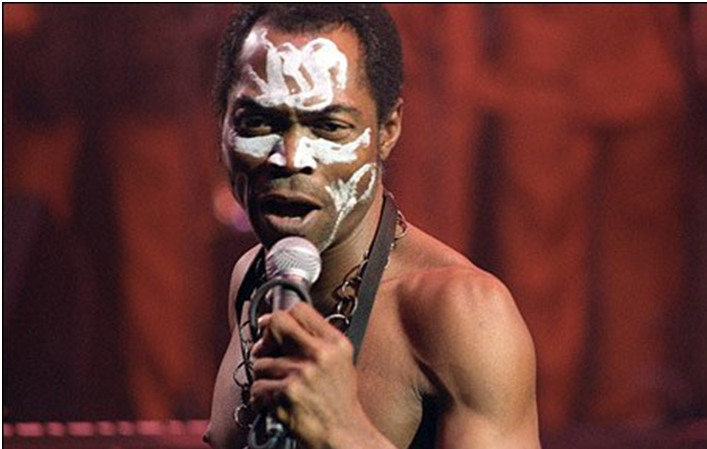October 15: Fela Kuti was born in 1938
Music is the weapon of the future
~Fela Anikulapo KutiImagine Che Guevara and Bob Marley rolled into one person and you get a sense of Nigerian musician and activist Fela Kuti.
— Herald Sun, February 2011
Teacher Don’t teach Me No Nonsense (live):
From Wikipedia:
| Birth name | Olufela Olusegun Oludotun Ransome-Kuti |
|---|---|
| Also known as | Fela Anikulapo Kuti Fela Ransome-Kuti |
| Born | 15 October 1938 Abeokuta, Nigeria |
| Died | 2 August 1997 (aged 58) |
| Genres | Afrobeat, Highlife |
| Occupations | Singer-songwriter,instrumentalist, activist |
| Instruments | Saxophone, vocals, keyboards,trumpet, guitar, drums |
| Years active | 1958–1997 |
| Labels | Barclay/PolyGram,MCA/Universal, Celluloid, EMI Nigeria, JVC, Wrasse,Shanachie, Knitting Factory |
| Associated acts | Africa ’70, Egypt ’80, Koola Lobitos, Nigeria ’70, Hugh Masekela, Ginger Baker, Tony Allen, Femi Kuti, Seun Kuti, Roy Ayers, Lester Bowie |
| Website | www.felaproject.net |
Fela Anikulapo Kuti (15 October 1938 – 2 August 1997), or simply Fela was a Nigerian multi-instrumentalist musician and composer, pioneer of Afrobeat music, human rights activist, and political maverick.
Music Style
The musical style performed by Fela Kuti is called Afrobeat, which is a complex fusion of Jazz, Funk, Ghanaian/Nigerian High-life, psychedelic rock, and traditional West African chants and rhythms. Afrobeat also borrows heavily from the native “tinker pan” African-style percussion that Kuti acquired while studying in Ghana with Hugh Masekela, under the uncanny Hedzoleh Soundz. The importance of the input of Tony Allen (Fela’s drummer of twenty years) in the creation of Afrobeat cannot be overstated. Fela once famously stated that “without Tony Allen, there would be no Afrobeat”.
Afrobeat is characterized by a fairly large band with many instruments, vocals, and a musical structure featuring jazzy, funky horn sections. The “endless groove” is used, in which a base rhythm of drums, shekere, muted West African-style guitar, and melodic bass guitar riffs are repeated throughout the song. Commonly, interlocking melodic riffs and rhythms are introduced one by one, building the groove bit-by-bit and layer-by-layer to an astonishing melodic and polyrhythmic complexity. The horn section then becomes prominent, introducing other riffs and main melodic themes.
| John Dougan (allmusic): It’s almost impossible to overstate the impact and importance of Fela Anikulapo (Ransome) Kuti (or just Fela as he’s more commonly known) to the global musical village: producer, arranger, musician, political radical, outlaw. He was all that, as well as showman par excellence, inventor of Afro-beat, an unredeemable sexist, and a moody megalomaniac. His death on August 3, 1997 of complications from AIDS deeply affected musicians and fans internationally, as a musical and sociopolitical voice on a par with Bob Marley was silenced. A press release from the United Democratic Front of Nigeria on the occasion of Fela’s death noted: “Those who knew you well were insistent that you could never compromise with the evil you had fought all your life. Even though made weak by time and fate, you remained strong in will and never abandoned your goal of a free, democratic, socialist Africa.” This is as succinct a summation of Fela’s political agenda as one is likely to find. ..read more @ allmusic.com |
Fela Kuti live in Berlin 1978 (full concert):
Album of the day – Gentleman (1973)
Sam Samuelson – allmusic:
Gentleman is both an Africa 70 and Afro-beat masterpiece. High marks go to the scathing commentary that Fela Anikulapo Kuti lets loose but also to the instrumentation and the overall arrangements, as they prove to be some of the most interesting and innovative of Fela’s ’70s material. When the great tenor saxophone player Igo Chico left the Africa 70 organization in 1973, Fela Kuti declared he would be the replacement. So in addition to bandleader, soothsayer, and organ player, Fela picked up the horn and learned to play it quite quickly — even developing a certain personal voice with it. To show off that fact, “Gentleman” gets rolling with a loose improvisatory solo saxophone performance that Tony Alleneventually pats along with before the entire band drops in with classic Afro-beat magnificence.
…read more @ allmusic.com
Other October 15
- Elvis’ Christmas Album is the fourth album by Elvis Presley on RCA Victor Records, LOC 1035, a deluxe limited edition, released in October 1957, and recorded at Radio Recorders in Hollywood. It has been reissued in numerous different formats since its first release. It spent four weeks at #1 on the Billboard Top Pop Albums chart, and was the first of two Christmas-themed albums Presley would record, the other being Elvis Sings the Wonderful World of Christmas, released in the early 1970s.
Released October 15, 1957 Recorded January–September 1957 Genre Christmas music, rock and roll Length 30:09 Label RCA Victor - Chris de Burgh (born Christopher John Davison, 15 October 1948) is an Argentinian born British-Irish singer-songwriter. He is most famous for his 1986 love song “The Lady in Red”, which reached number-one in Belgium, Canada, Ireland, Norway, and the United Kingdom.
-Egil





